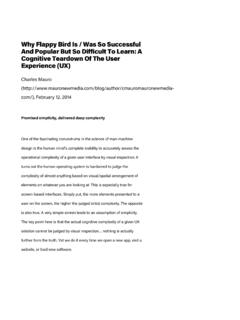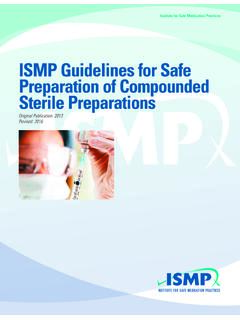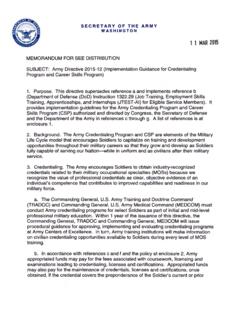Transcription of Constraint Satisfaction Problems (CSPs)
1 Constraint Satisfaction Problems (CSPs) Chris Amato Northeastern University Some images and slides are used from: Rob Platt, CS188 UC Berkeley, AIMA Assumptions about the world: a single agent, deterministic actions, fully observed state, discrete state space Planning: sequences of actions The path to the goal is the important thing Paths have various costs, depths Heuristics give problem -specific guidance Identification: assignments to variables The goal itself is important, not the path All paths at the same depth (for some formulations) CSPs are specialized for identification Problems What is search for?
2 What is a CSP? The space of all search Problems states and actions are atomic goals are arbitrary sets of states CSPs All search Problems The space of all CSPs states are defined in terms of variables goals are defined in terms of constraints A CSP is defined by: 1. a set of variables and their associated domains. 2. a set of constraints that must be satisfied. What is a CSP? Standard search problem : state is a black box any old data structure that supports goal test, eval, successor CSP: state is defined by variables Xi with values from domain Di goal test is a set of constraints specifying allowable combinations of values for subsets of variables Allows useful general-purpose algorithms with more power than standard search algorithms CSP example: map coloring problem : assign each territory a color such that no two adjacent territories have the same color Variables: Domain of variables: constraints .
3 CSP example: n-queens problem : place n queens on an nxn chessboard such that no two queens threaten each other Variables: Domain of variables: constraints : CSP example: n-queens problem : place n queens on an nxn chessboard such that no two queens threaten each other Variables: Domain of variables: constraints : One variable for every square Binary Enumeration of each possible disallowed configuration why is this a bad way to encode the problem ? CSP example: n-queens problem : place n queens on an nxn chessboard such that no two queens threaten each other Variables: Domain of variables: constraints : One variable for every square Binary Enumeration of each possible disallowed configuration why is this a bad way to encode the problem ?
4 Is there a better way? CSP example: n-queens problem : place n queens on an nxn chessboard such that no two queens threaten each other Variables: Domain of variables: constraints : One variable for each row ( , each queen) A number between 1 and 8 Enumeration of disallowed configurations why is this representation better? 1 2 3 4 5 6 7 8 The Constraint graph Binary CSP: each Constraint relates at most two variables Constraint graph: nodes are variables, arcs show constraints General-purpose CSP algorithms use the graph structure to speed up search , Tasmania is an independent subproblem!
5 A harder CSP to represent: Cryptarithmetic Variables: Domains: constraints : Another example: sudoku Variables: Each (open) square Domains: {1,2,..,9} constraints : 9-way alldiff for each row 9-way alldiff for each column 9-way alldiff for each region (or can have a bunch of pairwise inequality constraints ) Discrete Variables Finite domains Size d means O(dn) complete assignments , Boolean CSPs, including Boolean satisfiability (NP-complete) Infinite domains (integers, strings, etc.) , job scheduling, variables are start/end times for each job Linear constraints solvable, nonlinear undecidable Continuous variables , start/end times for Hubble Telescope observations Linear constraints solvable in polynomial time by LP methods Varieties of CSPs Varieties of constraints Unary constraints involve a single variable (equivalent to reducing domains), : Binary constraints involve pairs of variables, : Higher-order constraints involve 3 or more variables.
6 , cryptarithmetic column constraints Preferences (soft constraints ), , red is better than green often representable by a cost for each variable assignment ( , constrained optimization Problems ) Varieties of constraints Assignment Problems : , who teaches what class Timetabling Problems : , which class is offered when and where? Hardware configuration Transportation scheduling Factory scheduling Circuit layout Fault diagnosis .. lots more! Many real-world Problems involve real-valued Real-world CSPs States defined by the values assigned so far (partial assignments) Initial state: the empty assignment, {} Successor function: assign a value to an unassigned variable Goal test: the current assignment is complete and satisfies all constraints We ll start with the straightforward, na ve approach, then improve it Standard search formulation of CSPs What would BFS do?
7 What would DFS do? What Problems does na ve search have? Search methods Naive solution: apply BFS, DFS, A*, .. _ _ _ _ _ _ _ R _ _ _ _ _ _ R G _ _ _ _ _ R G R _ _ _ _ R G R R R R R .. How many leaf nodes are expanded in the worst case? Naive solution: apply BFS, DFS, A*, .. _ _ _ _ _ _ _ R _ _ _ _ _ _ R G _ _ _ _ _ R G R _ _ _ _ R G R R R R R .. How many leaf nodes are expanded in the worst case? Naive solution: apply BFS, DFS, A*, .. _ _ _ _ _ _ _ R _ _ _ _ _ _ R G _ _ _ _ _ R G R _ _ _ _ R G R R R R R .. How many leaf nodes are expanded in the worst case? This is bad.
8 How can we improve it? Backtracking search When a node is expanded, check that each successor state is consistent before adding it to the queue. Backtracking search When a node is expanded, check that each successor state is consistent before adding it to the queue. Does this state have any valid successors? Backtracking search Backtracking = DFS + variable-ordering + fail-on-violation What are the choice points? Backtracking enables us the ability to solve a problem as big as 25-queens Backtracking searchfunctionBacktracking-Search(csp)re turnssolution/failurereturnRecursive-Bac ktracking({},csp)functionRecursive-Backt racking(assignment,csp)returnssoln/failu reifassignmentis completethen returnassignmentvar Select-Unassigned-Variable(Variables[csp ],assignment,csp)for eachvalueinOrder-Domain-Values(var,assig nment,csp)doifvalueis consistent withassignmentgivenConstraints[csp]thena dd{var=value}toassignmentresult Recursive-Backtracking(assignment,csp)
9 Ifresult =failurethen returnresultremove{var=value}fromassignm entreturnfailureChapter 5 13 Forward checking Sometimes, failure is inevitable: Can we detect this situation in advance? Forward checking Sometimes, failure is inevitable: Can we detect this situation in advance? Yes: keep track of viable variable assignments as you go WA SA NT Q NSW V Forward checking Track domain for each unassigned variable initialize w/ domains from problem statement each time you expand a node, update domains of all unassigned variables Forward checking Track domain for each unassigned variable initialize w/ domains from problem statement each time you expand a node.
10 Update domains of all unassigned variables Forward checking Track domain for each unassigned variable initialize w/ domains from problem statement each time you expand a node, update domains of all unassigned variables Forward checking Track domain for each unassigned variable initialize w/ domains from problem statement each time you expand a node, update domains of all unassigned variables Forward checking But, failure was inevitable here! what did we miss? Forward checking propagates information from assigned to unassigned variables, but doesn t provide early detection for all failures: NT and SA cannot both be blue!















